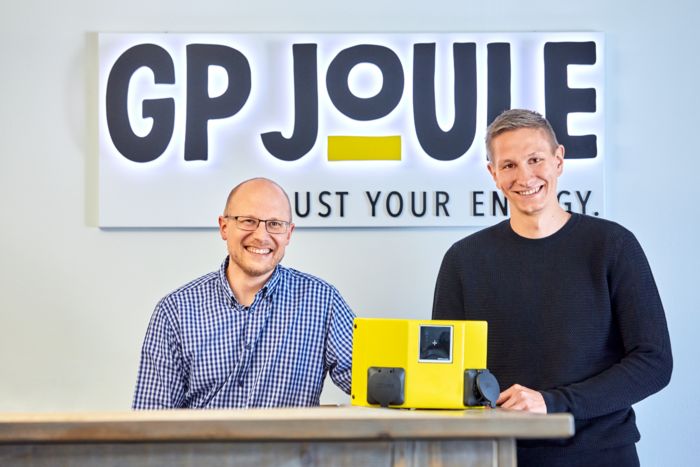Charging park with intelligent load management GP Joule uses photovoltaics, wind power, and biogas to charge electric cars and, together with Phoenix Contact, has developed a flexible load management solution for its company parking lot.

Overview
- GP Joule provides solutions for renewable power generation from the sun, wind, and biomass, and for e-mobility.
- Many companies are faced with the question of how to ensure the needs-based supply of electric cars with electricity.
- The solution is a load management system that ensures the rules-based distribution of the available connected load to all installed charging points.
- GP Joule found a flexible solution for its company parking lot and all customers in the CHARX manage software from Phoenix Contact.
Customer profile
Turn your own problem into a solution – GP Joule entered the electromobility market with this motto in 2015. Needs-based solutions were scarce, and so companies were becoming providers of e-mobility and charging infrastructure themselves – almost on a green field basis – with expert partners. GP Joule Connect has worked closely with Phoenix Contact E-Mobility GmbH since 2015.

Jonas Elbroend (left), Hardware Product Development, and Piet Gömpel, Software Product Development at GP Joule in Reußenköge, Germany
Application
The basic element of a new charging park is always the charging station. “Deficiencies, for example in terms of stability, user convenience, energy efficiency, and mains connection, are difficult to fix after the fact,” says Jonas Elbroend, based on his own experience as a hardware product developer at GP Joule Connect. “The built-in charging controller needs to control the current during the charging process, and also needs to be able to be controlled from a higher-level system.” Furthermore, the charging controller should be flexible so that different charging modes can be selected.
Other charging functions on the wish list included a 6 mA DC fault detection system and a 30 mA residual current device to protect the charging points and to switch the load. For charging mode 3, case B with charging socket, a voltage monitoring function should also be included in the charging controller for unlocking the charging connector in the event of a power failure.
For the load management system to be implemented, the charging points should be distributed in rotation across the three line conductors. This ensures that the maximum unbalanced load – specified by the energy provider – is not exceeded. Given the circumstances, the hardware and software must also be perfectly harmonized.

The correct charging controller (lower two rows) is the basis for optimum load management
Solution
The question of how the charging park’s power supply is ensured through the available connected load is of fundamental importance. “An energy management system is needed to control the energy flow of the charging park,” explains Elbroend. “This can either be autonomous – in other words, responsible for one charging park – or it can be part of a comprehensive building management system.” In an autonomous system, the available connected load is the only specified value for managing the charging park.
“The Ethernet-capable CHARX control advanced charging controllers and CHARX manage software from Phoenix Contact facilitate optimal energy management,” explains Piet Gömpel, software product developer at GP Joule Connect. “The controllers are managed by the software via Modbus/TCP. It also manages approval for the charging process and regulates the charging current.”

GP Joule can gradually extend the charging park as necessary
Charging park operators can either bill charging processes locally or using a billing system. GP Joule itself uses the software’s export function for billing and forwards the consumption data. In contrast, in the public sector, charging processes are usually billed by a backend provider. The backend provider receives the consumption data via OCPP – the protocol is an integral part of CHARX manage.
GP Joule now operates over 30 charging stations in Reußenköge and over 20 more at other locations. Extending the number of charging points is easy with the license model for 10, 30, or 50 charging points. “Our customers often start out with a basic installation with just a few charging points,“ says Gömpel. “With an upgrade license, the system can be extended flexibly at any time with additional charging points.”

With CHARX manage, employees have access to diagnostic information on the charging status and occupancy time
With CHARX manage, the parameters for the charging park, individual charging points, load management, and connection to the billing system are configured easily in a web-based interface. From any PC via a web browser. If, for example, the operator is logged in, relevant settings can be viewed or changed.
If a central terminal with touch PC and RFID reader is available to the electric car driver to log in, the charging point can be selected and the charging process started via an intuitive user interface. Alternatively, a box PC can be used and each charging point can be equipped with an RFID reader for user login.
Summary
Using this approach, GP Joule Connect brought around 300 charging points into operation in 2019. To meet the demanding customer requirements regarding operation, energy management, and availability, functions for using cloud services are also implemented in the CHARX manage software.
As Jonas Elbroend says in summary, “CHARX manage from Phoenix Contact is tailored to companies that want to use between ten and several dozen charging points in the future and which have professional requirements for energy management, operation, and upgrade security.“
As Piet Gömpel adds, “With CHARX manage, our charging solutions can be used flexibly in different environments in charging parks. We can use it to offer our growing customer base a complete solution, from analysis, planning and implementation, all the way to operation.”

